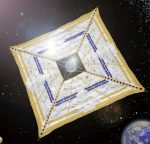The Planetary Society recently announced its new LightSail project, a program to sail a spacecraft on sunlight alone by the end of 2010. The new solar sail project was unveiled at an event celebrating the 75th anniversary of the birth of Planetary Society co-founder Carl Sagan, a long-time advocate of solar sailing.
The LightSail project will launch three separate spacecraft over the course of several years. LightSail-1 will demonstrate sunlight alone can propel a spacecraft in Earth orbit while LightSails 2 and 3 will reach farther into space. The Society believes that sailing on light pressure is also the only known technology that might carry out practical interstellar flight. As a craft moves further away from the sun, the solar "fuel" would be provided by concentrating lasers.
Lightsail-1 will into a volume of just three litres before unfurling to become the "engine" of a small spacecraft.
Reflected light pressure propels solar sails through the push of photons against a mirror-bright surface. LightSail-1 will be constructed from 32 square meters of Mylar and have four triangular sails, arranged in a diamond shape resembling a kite. LightSail-1 will be placed in an orbit over 800 kilometres above Earth, high enough to escape the drag of Earth’s uppermost atmosphere. At that altitude the spacecraft will be kept in orbit by gravity and the pressure of sunlight on its sails will increase its orbital energy.
Lightsail-2 will engage in longer flights to higher Earth orbits while LightSail-3 will go to what’s known as the Sun-Earth Libration Point, L1, where solar sails could be permanently placed as solar weather stations, monitoring geomagnetic storms from the Sun that potentially endanger electrical grids and satellite systems around Earth.
The Planetary Society’s attempt in 2005 to launch the world’s first solar sail was defeated when a Russian Volna rocket used as a launch vehicle failed to reach Earth orbit.
More on the LightSail Project








































